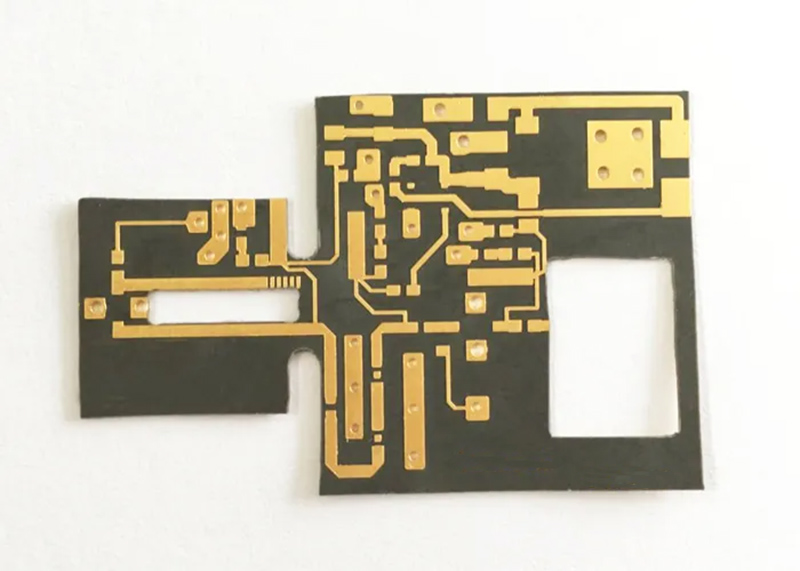Rogers 4350B dielectric constant (Dk) exhibits stability across frequencies, with a Dk value of 3.48 and minimal variation over the frequency range from 500 MHz to over 40 GHz. Such characteristics make the material ideal for high-frequency circuit design to ensure signal transmission quality and integrity. Dielectric constant is a property that measures the response of a material to an electric field. It reflects a material's ability to store energy in an electric field, and for circuit board design, the dielectric constant directly affects the speed of signal propagation, attenuation, and signal integrity. For Rogers 4350B, the stability and relatively low value of the dielectric constant facilitates high frequency signal propagation, especially at 10 GHz.
The Rogers 4350B dielectric constant remains stable over the frequency range of 500 MHz to 40 GHz, demonstrating its ability to have consistent electrical characteristics over this band. This stability aids in the design of impedance-controlled transmission lines and matching networks to ensure consistent and effective signal transmission.
The material has a low loss tangent of approximately 0.0037,which means that there is very little attenuation of the signal as it passes through the material.This characteristic is particularly critical for high frequency signal transmission,helping to reduce signal distortion and attenuation,ensuring signal integrity and reliability.
In high-frequency applications,the material's dielectric constant stability and low loss properties greatly improve the quality of signal transmission.Rogers 4350B is widely used in the design of demanding high-frequency circuits such as wireless communications and radar, showing its good adaptability and performance.
When designing circuits,engineers need to consider the effect of dielectric constant on impedance matching and signal integrity. Because changes in dielectric constant can directly affect signal propagation speed and attenuation, choosing the right material such as Rogers 4350B can effectively improve the overall performance and stability of the circuit.
Although the dielectric constant of Rogers 4350B exhibits good stability over the measured frequency range, its performance may change at very high frequencies (e.g., over 40 GHz). Therefore,designers anticipating higher signal frequencies should analyze the material properties in more detail to ensure the reliability and effectiveness of the circuit design.

Advantages of Rogers 4350B Dielectric Constant
With a dielectric constant of 3.48, Rogers 4350B is particularly favorable in high frequency applications.This low dielectric constant reduces signal delay while minimizing signal loss, providing stable performance in high-frequency devices.At the same time,the material maintains good performance in most environments,ensuring that circuits are reliable under varying operating conditions.
1.Low Dielectric Loss Characteristics
Rogers 4350B material has a low dielectric loss (Dissipation Factor), so that the signal propagation process with minimal loss.This feature ensures the integrity of the high-frequency signal, which reduces signal distortion and improves overall system performance.
2.Temperature Stability
The dielectric constant of this material exhibits extremely low fluctuations in temperature, making it suitable for high frequency operation in a variety of temperature environments. This temperature stability allows the Rogers 4350B material to maintain excellent electrical performance in a wide range of application scenarios.
3.Wide Frequency Range Adaptability
The dielectric constant of Rogers 4350B remains stable over a wide frequency range, making it ideal for use in many high frequency and broadband applications. This allows designers to design high-frequency circuits without worrying about performance degradation due to frequency changes.
4.Good Electrical Performance Control
Rogers 4350B material allows engineers to achieve tight dielectric constant control in their designs. This is especially critical for radio frequency (RF) circuit designs that require high accuracy and performance to ensure design consistency and reliability.
5.Reduced Manufacturing Costs
Due to the advantages of Rogers 4350B's dielectric constant and loss control, the use of this material can reduce overall manufacturing costs without compromising circuit performance. This makes it not only a technically superior but also an economical choice for commercial applications.
The Rogers 4350B dielectric constant has a significant impact on circuit performance in a number of areas such as signal transmission, loss, temperature stability and impedance matching:
1. Signal Transmission
The Rogers 4350B has a dielectric constant of approximately 3.48. This lower dielectric constant helps to increase the speed of the signal during propagation, thereby reducing signal delay and enhancing signal integrity. Circuit designers are able to take advantage of this feature to optimize board layout to improve overall performance.
2.Signal Loss
Dielectric constant directly affects signal transmission loss. A lower dielectric constant usually means a lower dielectric loss (Df), and Rogers 4350B materials can have a loss factor as low as 0.0037. This low-loss characteristic makes the material particularly suitable for high-frequency applications, helping to minimize performance degradation due to signal attenuation.
3.Temperature Stability
The dielectric constant of Rogers 4350B remains stable over a range of temperatures. This characteristic helps to improve the thermal stability of the circuit, allowing it to maintain good performance under varying environmental conditions. This feature is especially important in many high frequency applications where circuits are required to operate at extreme temperatures.
4.Impedance Matching
The dielectric constant affects the impedance characteristics of the transmission line in a circuit. When designing a transmission line, the designer must ensure that the dielectric constant of the material can match the impedance of the entire circuit to avoid signal reflection and attenuation. The use of Rogers 4350B material with the right dielectric constant can effectively achieve impedance matching, thus ensuring the smooth transmission of signals.
5.Process Adaptability
Rogers 4350B material can be combined with standard epoxy resins and glass fibers for easy fabrication and processing. This compatibility allows for greater flexibility in the design and production process. Utilizing a suitable dielectric constant, the material is able to meet the needs of a diverse range of applications, thus providing an efficient solution.
As a high-performance circuit board material, Rogers 4350B plays a vital role in high-frequency applications due to the stability and low value of its dielectric constant. Its positive impact on signal transmission speed,signal loss,temperature stability and impedance matching enables designers to achieve efficient circuit design and optimization.